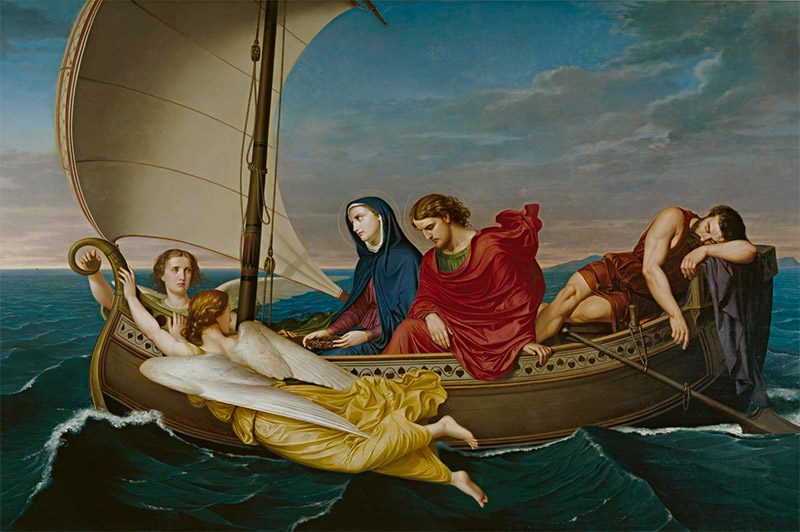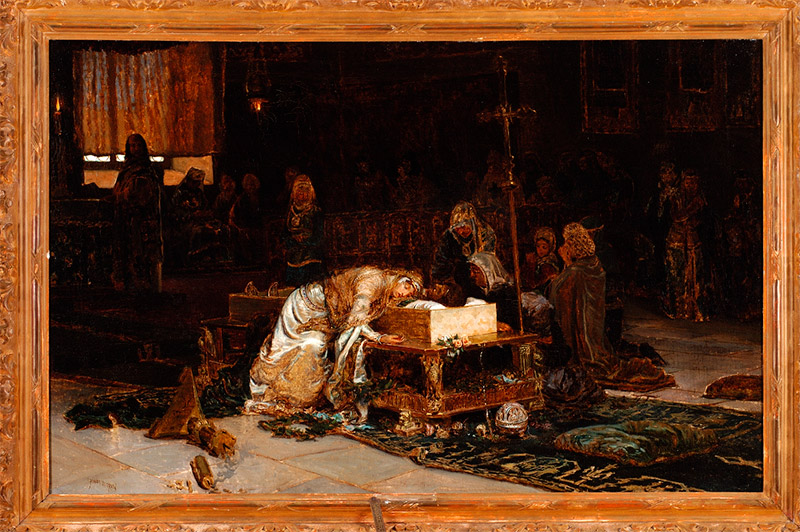
paint
The liberal revolution had a huge impact on the cultural field and, of course, also on the arts. The ecclesiastical bankruptcy caused by the confiscations of church property by Mendizábal and Madoz ended the patronage of the Church, but also, from the time of Ferdinand VII, that of the Crown and, above all, that of the aristocracy. The monarchy thus lost control of the artistic world through the Academies, which became state-owned. The bourgeoisie, whether privately or through official institutions, imposed the new aesthetic taste, dominated in the field of painting by history paintings, portraits, landscapes and costumbrismo.
This expansion of liberal ideology in the field of the arts was helped by the decline of the San Fernando Academy of Arts, which was inextricably linked to classicism and therefore somewhat outdated by the first third of the 19th century. Institutions such as the Ateneo, founded in 1820 and re-founded in 1835, or the Liceo, founded in 1837, on the other hand, responded better to the needs of the times. Even so, the Academy continued to be influential by providing part of the jury for the National Exhibitions, which the Ministry of Public Works began to promote in 1856. These biennial competitions were an attempt, directly sponsored by the State, to professionalise the sector, becoming the main meeting point for artists and buyers, generally museums and public bodies. The rise of historical painting, actively promoted by official institutions, always in search of emotional support, is the best expression of the importance of the National Exhibitions.
The main point of the artistic programme linked to the liberal project was the creation of a national museum of painting. After the vain attempts by Joseph I to create a museum in the Buenavista Palace to display the works from the requisitions carried out during the Napoleonic invasion, the Academy of San Fernando took on a similar project during the reign of Ferdinand VII, which also failed to come to fruition. It was not until November 1819, possibly due to the influence of Isabel de Braganza, the monarch’s second wife, that the Prado Museum was inaugurated in a new location, with funds coming mostly from the royal art gallery. This gave rise to a long dispute over the Crown’s desire to preserve the collection, a situation that continued until the dethronement of Isabel II in 1868, at which point the funds became part of the national heritage. The royal collections were increased with the funds deposited in the Museum of the Trinity, created in 1837 to house works from the Mendizábal confiscation.
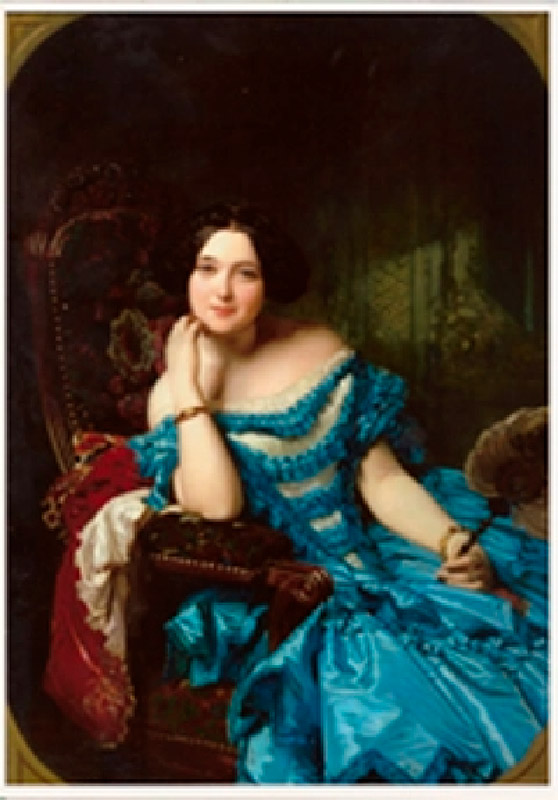 The portrait
The portrait
The liberal revolution had a huge impact on the cultural field and, of course, also on the arts. The ecclesiastical bankruptcy caused by the confiscations of church property by Mendizábal and Madoz ended the patronage of the Church, but also, from the time of Ferdinand VII, that of the Crown and, above all, that of the aristocracy. The monarchy thus lost control of the artistic world through the Academies, which became state-owned. The bourgeoisie, whether privately or through official institutions, imposed the new aesthetic taste, dominated in the field of painting by history paintings, portraits, landscapes and costumbrismo.
Chamber painters and academic purism
The maintenance of the drawing tradition inherited from classicism, in line with what was advocated by the German Nazarenes or the purism of Ingres, is represented in Spain by the portrait painters attached to the court.
An example of this is the work of the sons of Vicente López (1772-1850), Bernardo López Piquer (1799-1874), also the first chamber painter, and his brother Luis (1802-1865), with a more personal style and author of the celebrated painting The Coronation of Quintana by Queen Isabel II (1855, Senate Palace, on loan from the Prado Museum), a collective portrait of the most relevant figures in the culture of the time.
It is also worth remembering the work of Juan Antonio Ribera (1779-1860), a disciple of Bayeu and David, who introduced him to historical painting during his stay in Paris. After following Charles IV into exile in Rome, upon his return to Madrid he was appointed chamber painter, director of the Prado Museum and professor at the Royal Academy of San Fernando. Notable among his works is The Destruction of Numancia (Royal Academy of San Fernando, Madrid).
Another disciple of David was José de Madrazo (1781-1859), founder of the Royal Lithographic Establishment in 1830.
His son Federico de Madrazo y Kuntz (1814-1894), the quintessential portrait painter of the Elizabethan era, was appointed chamber painter to the queen in 1857, painting her 28 times, not to mention the paintings dedicated to Luisa Fernanda (1851, Royal Palace, Madrid) or the Countess of Vilchez (1853, Museo del Prado-Casón), perhaps his best-known work. He introduced the purist current most akin to Ingres into Spanish Romantic painting, and his orderly compositions, characterised by sharp drawing and a somewhat conventional choice of colour, link him to Nazarene archaism. His search for the Baroque roots of Spanish painting was also reflected in The Great Captain Contemplating the Corpse of the Duke of Nemours after the Battle of Ceriñola (Private Collection, Madrid), which clearly has Velazquezian references.
Carlos Luís de Ribera (1815-1891), appointed court painter and professor at the Royal Academy of San Fernando in 1846, was a teacher of the best history painters of the following generation. The decoration of the Hall of Sessions of the Congress of Deputies (1850) is his most outstanding work, although he touched upon various genres, from historical paintings to religious themes, as well as portraits, in which he showed particular assurance, as evidenced by The Family of Don Gregorio López Mollinedo (1854, Private Collection, Madrid), an academic work but with notes that refer very clearly to the Spanish pictorial tradition.
Antonio Gómez Cros (1809-1863) was above all a religious painter, as shown in The Decapitation of the Innocents (1855, University of Barcelona, on loan from the Museo del Prado), where, starting from the Baroque tradition and classicist drawing, he was able to integrate theatrical features of a romantic taste. However, his work as a portrait painter, in the style of his teacher V. López, was also very outstanding. Representative of his work in this field is the painting he dedicated to Cecilia Rodríguez and her daughter (1844, Museo Romántico).
The Seville school in Madrid
Less rigorous in their academicism, due to their training in the Fine Arts schools of Cadiz and Seville – so dependent on Murillo’s colourism is the notable group of Andalusian painters who would end up developing their careers in Madrid.
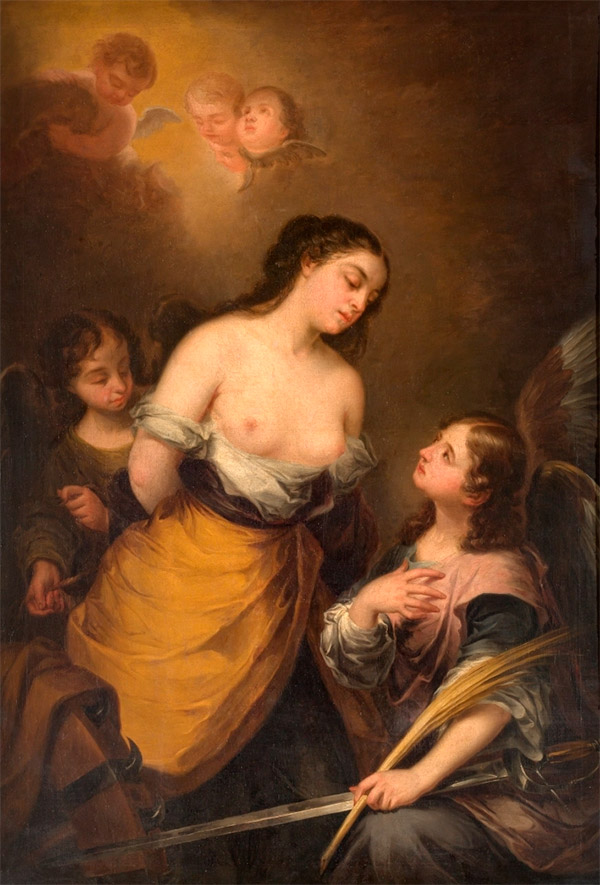
José Gutiérrez de la Vega (1791-1856), greatly inspired by the delicate English portrait model, but above all by Murillo, his works are characterised by the predominance of soft colours, which envelop the figures in a subtle and almost unreal atmosphere, not devoid of sensuality. Good examples of this are the portraits of Isabel II, of the Duchess of Frías or of Larra. Nevertheless, his production also includes some magnificent paintings on religious themes, such as The Saints Justa and Rufina (ca. 1846, Royal Palace, Madrid) or The Martyrdom of Saint Catherine (ca. 1846, Museo del Prado-Casón).

Antonio María Esquivel y Sáenz de Urbina (1806-1857), despite having cultivated different genres, is remembered for his portraits of prominent members of the country’s politics, such as Prim, Espartero, Mendizábal, or intellectuals, especially the groups A reading of Ventura de la Vega on the stage of the Teatro del Príncipe (1845, Museo Romántico, Madrid) and A reading of Zorrilla in the painter’s studio (Museo del Prado-Casón). His style, characterized by its moderate romanticism and a certain proximity to the Murillo heritage, can also be seen in his paintings on religious subjects, such as The Chaste Susanna (Museum of Fine Arts, Seville) and in some others on historical themes, especially The Bell of Huesca (1850, Museum of Fine Arts, Seville).
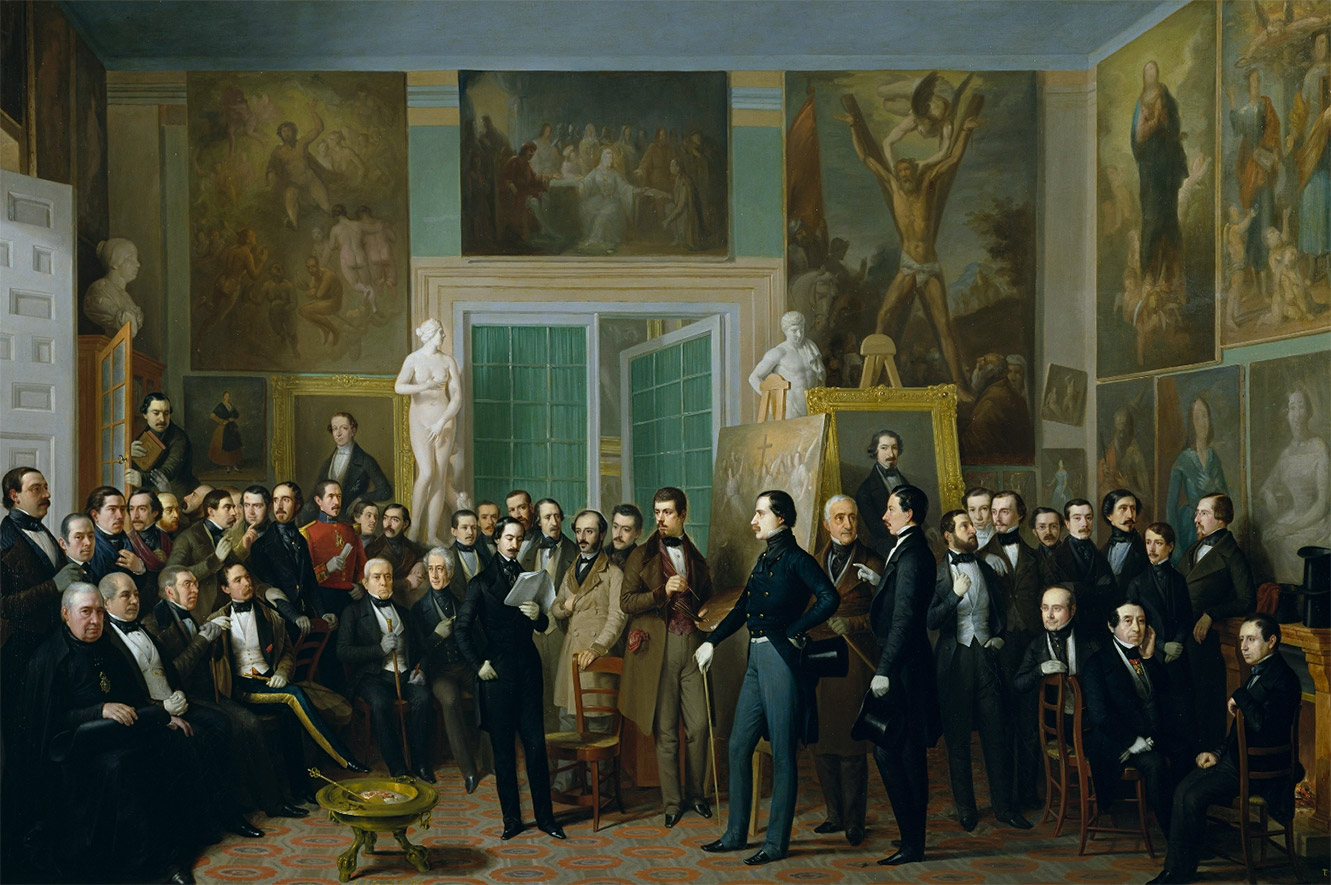
Although more inclined towards the traditional, Ángel M. Cortellini (1819-c. 1887) also dealt with portraiture, of which he left a good example of his work in those he dedicated to Isabel II and to Francisco de Asís (ca. 1852, Museum of Fine Arts, Santander).
 The Barcelona school in Madrid
The Barcelona school in Madrid
Joaquím Espalter Rull (1809-1880) was another outstanding painter of group portraits, generally of bourgeois family groups, such as The Family of the Banker José Flaquer (Museo Romántico, Madrid) or Portrait of the Muntades Couple. He also painted frescoes for the halls of the presidency of the Congress of Deputies and the auditorium of the University of Madrid (1858). He also painted historical paintings, such as The Sigh of the Moor (1855), and religious paintings, such as The Christian Era (1871, Museu d’Art de Gerona, on loan from the Museo del Prado).
From the pictorial production of Josep Galofré i Coma (1819-1877), theorist par excellence of anti-academicism, we can highlight his painting The Coronation of Alfonso V in Naples (1846).
Religious painting
The Nazarene purism of the Llotja School in Barcelona The influence of the Nazarenes, the group of German painters established since 1810 in the convent of San Isidoro in Rome, defenders of a mysticism expressed through the formal purism embodied by the painters of the Italian Quattrocento, had a particularly marked echo among the students of the Llotja School in Barcelona.
To names like Jaume Batlle Mir (1801-1865) or Josep Arrau i Barba (1802-1872), we should add Lluis Ferrant i Llausás (1806-1868), a very capable portrait painter, who is the author of a good number of paintings. religious, or that of Pau Milà i Fontanals (1810-1833).
However, Pelegrí Clavé i Roqué (1811-1880) is possibly the most notable author of the entire group from L’escola de Llotja. From his stay in Mexico, the painting Dementia of Isabel of Portugal (1855, San Carlos Museum, Mexico) stands out.
It is also worth remembering the work of Claudi Lorenzale i Sugranyes (1816-1889), author of The Creation of the Coat of Arms of Barcelona (1843, Academia de Sant Jordi, Barcelona), very much in line with Nazarene purism and a seminal work of Catalan pictorial nationalism.
Of somewhat lesser importance are the works of Francesc Cerdá de Villarestán (1814-1881), author of works on historical and religious subjects, and of Eusebi Valldeperas (1827-1900).
El purismo nazareno de la Academia de San Fernando de Madrid
Somewhat later than in Barcelona, the influence of the Nazarenes among Madrid painters was no less profound.
Luís de Madrazo y Kuntz (1825-1897), another member of the well-known dynasty of painters, stands out in this field for his compositions of religious inspiration, such as the Burial of Saint Cecilia (1852, Municipal Museum, Madrid, loaned by the Prado Museum), but also for his portraits.
A Germán Hernández Amores (1827-1894), a skilled draughtsman, greatly influenced by Overbeck and Gleyre, is responsible for one of the most finished works of Spanish Nazarenism, The Virgin and Saint John on their Journey to Ephesus after the Death of the Redeemer (Museo de Murcia, on loan from the Museo del Prado).
Domingo Valdivieso y Henarejos (1832-1872) is another author related to the group. His works include La Primera Comunión y Felipe II in an Auto de Fe.
Local customs
The Andalusian School The Andalusian School of costumbrist painting, which began in Cadiz, was characterised above all by its folkloric themes, full of festive themes, bullfights, weddings and processions, which largely responded to the demand for Andalusian scenes coming from France and especially from England. This established an unproblematic image of the homeland, populated by fixed iconographic types, such as the majo, the bullfighter, the beggar, the bandit and the flamenco dancer. In these paintings, which are generally small in size, the drawing, which is more academic and scenographic, predominates over the colour, which is generally very vivid, with the influence of Murillo and his school sometimes being evident.
Juan Rodríguez Jiménez “El Panadero” (1765-1830) is considered the initiator of the costumbrista movement, thanks to paintings such as El baile del farol (Romantic Museum, Madrid), with agile brushstrokes and full of light contrasts. He also painted the mural decorations of the presbytery of the church of San Agustín in Seville and the church of the Encarnación in Lisbon.
Joaquín M. Fernández Cruzado (1781-1856) was possibly the most outstanding representative of this group of painters. His style, linked to the neo-baroque academicism similar to Zurbarán and Murillo, is well reflected in works such as Prison of Guatimozín, last Aztec emperor (1841, private collection, Cádiz) or Detail of the Mass (Bilbao Museum).
La obra de José Elbo (1804-1844) is characterized by its loose brushstrokes and contrasting colors, a reflection of the influence exerted by Goya on his work, as can be seen in Una venta (1843, Museo Romántico, Madrid) or in La familia de Cayetano Fuentes (1837, Museo Romántico, Madrid), two of his best-known works.
José Roldán (1808-1871) adopted Murillo’s soft tones, which he captured in paintings such as La Caridad (Royal Palace, Aranjuez). However, the most notable part of his work, his family portraits, also show a clear British influence, noticeable, for example, in Los niños de la familia Lara (Museo del Prado).
El linaje de los Bécquer se inicia con Joaquín Domínguez Insausti Bécquer (1817-1879), hábil dibujante y pintor de cámara desde 1850. La vista de Sevilla desde la Cruz del Campo (1853, Museo de San Telmo, San Sebastián) es uno de sus trabajos más renombrados.
 The painter and illustrator José Domínguez Insausti Bécquer (1805-1845), cousin of Joaquín Domínguez Bécquer and father of Valeriano Bécquer, is the creator of some of the most important types and commonplaces of costumbrista painting, especially bullfighters, bandits, dancers, etc.
The painter and illustrator José Domínguez Insausti Bécquer (1805-1845), cousin of Joaquín Domínguez Bécquer and father of Valeriano Bécquer, is the creator of some of the most important types and commonplaces of costumbrista painting, especially bullfighters, bandits, dancers, etc.
Valeriano Bécquer (1833-1870), son of José Domínguez Insausti Bécquer and brother of the famous poet Gustavo Adolfo, was undoubtedly the most gifted painter of the entire family and one of the leading figures of the costumbrismo pictorial of his time. His works that deserve to be highlighted are Baile de aldeanos sorianos (Museo del Prado) or El maderador (Museo del Prado), as well as La fuente de la ermita de Sonsoles (Museo Romántico, Madrid) or Nodriza pasiega (Museo Romántico, Madrid). In all of them, in addition to his mastery of drawing, he shows an expressiveness largely removed from the purest Sevillian typicality, capable of connecting, beyond Murillo and Velázquez, with a certain psychological depth taken from Goya.
A disciple of José Domínguez Bécquer was Manuel Rodríguez de Guzmán (1818-1867), whose motley compositions, intense colours and precise drawing can be seen in paintings such as The Fair at Santiponce (Prado-Casón Museum), The Procession of El Rocío (Riofrío Palace, Segovia) or Dance at La Virgen del Puerto (Romantic Museum, Madrid).
From the work of Manuel Cabral y Aguado Bejarano (1827-1891), son of the painter Antonio Cabral, stands out The Corpus Christi Procession in Seville (1857, Museo del Prado-Casón), where it shows some of the most outstanding features of his style, such as his love for detail and a certain tendency towards the conventional use of colours.
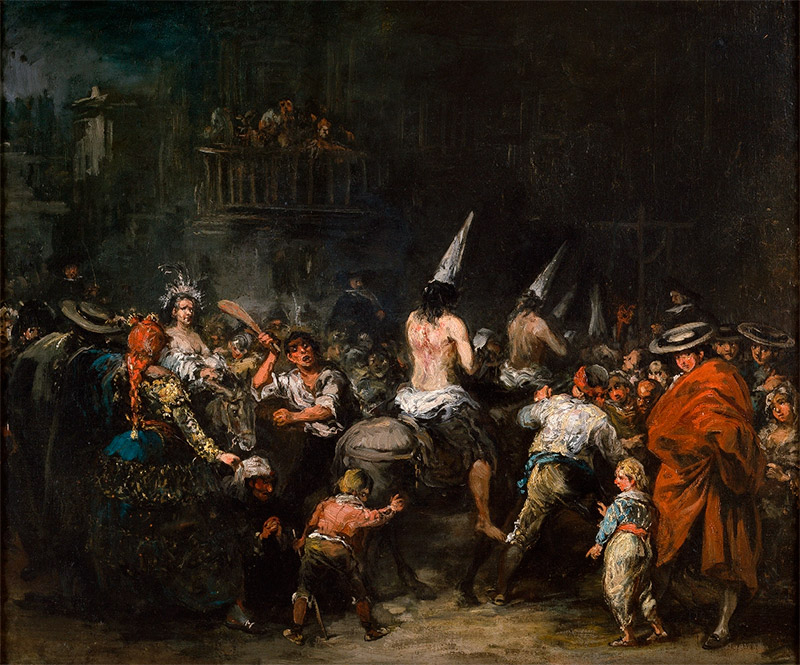 The Madrid school
The Madrid school
Related to the critical Goya of after 1792, Madrid costumbrismo is characterized by a tense and torn vision of popular reality, cruel and sometimes dreamlike. Its most evident formal features are the predominance of contrasting colors, close to tenebrism, and an execution dominated by the use of rapid strokes and blurred drawing.
Leonardo Alenza y Nieto (1807-1845), another great draughtsman, was interested in the sordid street world of Isabelline Madrid, as demonstrated in The Farewell on the Gallows (Budapest Museum), The Whipping (Prado Museum) and The Silly Soup (Lázaro Galdiano Foundation). Also famous are his satires The Romantics (Romantic Museum, Madrid) and Romantic Suicide (Romantic Museum, Madrid). His technique is characterised by his agile use of colourful brushstrokes, halfway between Goya and Velázquez.
The prolific Eugenio Lucas Velázquez (1817-1870), a follower and sometimes imitator of Goya, painted pictures of the Inquisition, majos, pilgrimages and bullfights, as well as others on historical subjects. His versatile style, with its energetic brushstrokes and remarkable display of colour, is reflected in three of his most famous works: A Condemned Man (Museo del Prado), The Luck of the Sticks (ca. 1855, Museo del Prado) and Procession Interrupted by the Rain (Hispanic Society, New York).
Within the same orientalist line in which Delacroix stood out, the Cadiz-born Francisco Lameyer y Berenguer (1825-1877) developed numerous compositions on African themes, such as A Jewess in Tangier (Metropolitan Museum, New York) or Assault of Moors on a Jewish Quarter (Museo del Prado-Casón), characterized, like the rest of his work, by the intense color, the nervousness of his compositions and the ease of his technique.
Landscape
As is well known, the landscape is understood in romantic thought as an extension of the artist’s soul, charged with overflowing emotions, which are reflected in the representation of raging seas and storms, or abysses and twilights, which evoke the loneliness of man in the immensity of creation. The landscape, moreover, is seen as something historical, changeable, hence the incorporation of ruins of castles or Gothic temples, but also, in its more serene aspect, of the intervention of man in its formation, giving rise to the representation of idealized but concrete rural landscapes, tinged with local color through the integration of popular types, peasant processions or bandits, which gave the work a nascent regionalist sense.
Although they did not form a defined school, the romantic landscape painters in Spain form a movement, not always valued by critics, which brings together a group of personalities influenced by foreign references, the flamenco tradition and the British above all, similar in their search for the picturesque, uniting emotional landscapes, local customs in the characters and historicist references in the architectures, all in favour of a reaffirmation of the local and the specific.
Among Spanish landscape painters, drawing, watercolours and, in particular, engraving, which were less elitist and more in keeping with the spirit of capitalism, were more used as vehicles of expression than oil paintings, as can be seen in the series Recuerdos y bellezas de España (1839-1865), with lithographs by Parcerisa, or España fotosesca y artística (1844-1847), with lithographs by Van-Halen, following in the wake of España artística y monumental (Paris, 1842-1844), illustrated by Villaamil and with texts by Patricio de la Escosura.
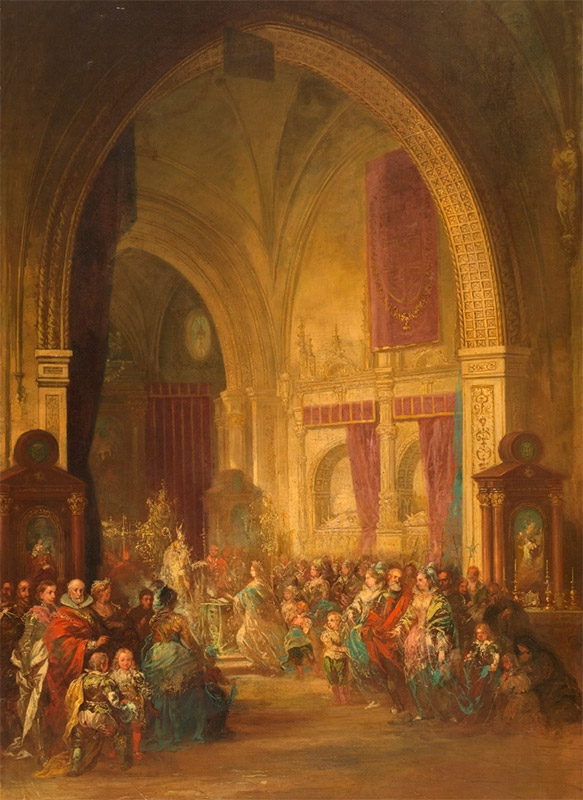
The Madrid circle
Among the Spanish cultivators of the genre, the most important of all is undoubtedly Jenaro Pérez Villaamil (1807-1854). Strongly influenced by British landscape painters such as Roberts, Lewis and Turner, after an initial period of pre-romantic eclecticism (c. 1823-1833), his imaginative style, with a paste-up technique and warm colours, is well reflected in canvases such as Las gargantas de las Alpujarras (Fundación Santamarca, Madrid), Los Picos de Europa (1847, Palacio de la Moncloa) and Sevilla en tiempo de los Árabes (1848, Palacio del Pardo).
Also notable in the field of landscape is the work of Antonio Brugada (1804-1863), a disciple of Th. Gudin and, like him, specialized in marine landscapes with ships, of which Wreck of a French Ship next to a Lighthouse (1841, Fundación Santamarca, Madrid), Episode of the Naval Battle of Lepanto (Prado Museum, on loan to the Museu Marítim de Barcelona) and The Battle of Cape San Vicente (Naval Museum, Madrid) are good examples.
Vicente Camarón (1803-1864) was also a marine painter, although to a lesser extent. His landscapes were greatly influenced by the flamenco tradition, as is evident in his Pack of Wild Boars (1845, Fundación Santamarca, Madrid).
The work of Fernando Ferrant y Llausás (1810?-1854) was dedicated exclusively to landscape painting, generally heirs to French classicism, but endowed with the luminous lyricism shown in Landscape with Lake and Hermitage in Ruins (ca. 1845, Granja de San Ildefonso, Segovia).
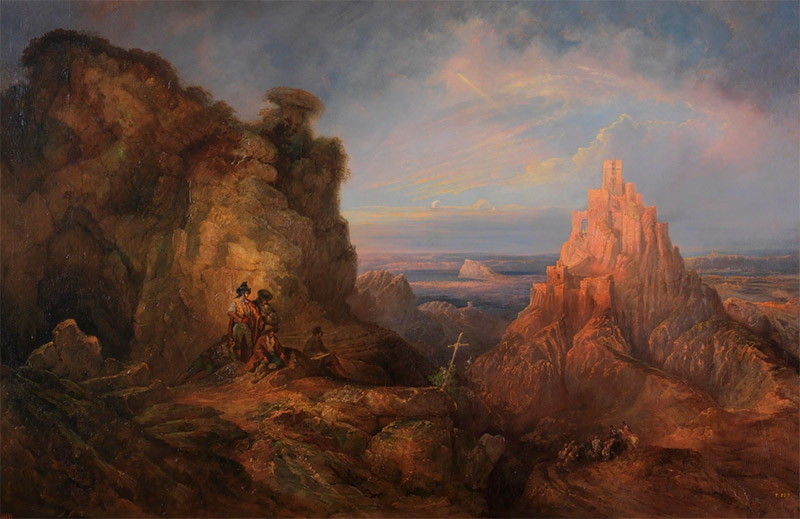 The landscapes of the versatile José M. Barrial y Flores (1807-1891) are marked by their archaeological detail, not exempt at times from a certain lyricism close to that of British landscapers.
The landscapes of the versatile José M. Barrial y Flores (1807-1891) are marked by their archaeological detail, not exempt at times from a certain lyricism close to that of British landscapers.
Francisco de Paula Van-Halen y Maffei (c. 1800-1887), a historical painter, is also the author of landscapes influenced by the style of Jenaro Villaamil. View of the Monastery of El Escorial (Royal Palace, Madrid) is an example of this.
Some works by Cecilio Pizarro (c. 1820-1886) are also worth highlighting, such as his Interior of San Juan de los Reyes in Toledo (Museo Romántico, Madrid).
The Seville circle
Given the similarity between costumbrista painting and landscape painting, it is not surprising that many Andalusian authors were keen to cultivate landscape painting. Manuel Barrón y Carrillo (1814-1884) is the best exponent of this group. His work, in the style of Villamil, is perfectly captured in Contrabandistas en la Cueva del Gato (1860, Seville Museum) or in Vacas a la orilla del Guadalquivir (1860, Seville Museum).
Andrés Cortés (c. 1815-c. 1879) signed the painting The Seville Fair (Conde de Ibarra Collection, Seville), his most celebrated work, where he expresses his taste for panoramic views.
The Barcelona circle
The name of the self-taught painter and draughtsman Francesc-Xavier Parcerisa (1803-1876) is inextricably linked to the 588 lithographs in the monumental work Recuerdos y bellezas de España (Recollections and Beauties of Spain), in eleven volumes, each one dedicated to a region of the country, accompanied by texts by Francisco Pi y Margall, Pablo Piferrer, Pedro de Madrazo and José M. Quadrado. In the same vein, he was the author of paintings of monuments, such as Exterior of Burgos Cathedral (1860, Museo del Prado-Casón).
Lluis Rigalt i Fabriols (1814-1894) was early influenced by the work of his father, the stage designer and first professor of Landscape at the Escola de Llotja de Pau Rigalt (1778-1845), as can be seen in Landscape with Ruins (1865, Museu d’Art Modern, Barcelona) and others, such as Souvenir of Catalonia (Museo del Prado, on loan to the Monastery of Poblet), View of Mongat and Skirt of Montjuic, all of them characterised by their precise drawing and careful treatment of light. He also collaborated as a draughtsman on the work Spain. Picturesque Work.
The first history painting
Romantic historical painting was introduced into Spain by the group of courtly painters, disciples of David, who, despite still maintaining neoclassical orthodoxy in form, began to deal with themes from national history in their paintings, foreshadowing the definitive consecration of the genre in 1856, with the first National Exhibition of Fine Arts.
If a disciple of David like the court painter José de Madrazo (1781-1859) introduced the theme in Assault on Montefrío by the Great Captain (1838), his son, Federico de Madrazo y Kuntz (1814-1894), painted in 1835 what can be considered the first painting in the history of Spanish Romanticism, The Great Captain contemplating the corpse of the Duke of Nemours after the battle of Ceriñola (Private collection, Madrid).
Another leading cultivator of the genre was Juan Antonio Ribera (1779-1860), a disciple of Bayeu and David, who introduced him to it during his stay in Paris. Among his works, the most notable is The destruction of Numancia (Royal Academy of San Fernando, Madrid). In 1825 he decorated one of the rooms of the El Pardo Palace with the Parnassus of the great men of Spain. His son, Carlos Luís de Ribera (1815-1891), made in 1831, when he was 16 years old, The discovery of the South Sea by Vasco Núñez de Balboa, which was followed by The investiture of Enrique el Doliente as Prince of Asturias (1835). He continued to cultivate the genre in Don Rodrigo Calderón at the act of being led to the torture (1845), in The origin of the surname of the Girones (1849) and Granada, Granada, by the kings Don Fernando and Doña Isabel! (1853-1890, Cathedral, Burgos).
Some other initials of this genre by Antonio María Esquivel are worth highlighting, such as Don Sancho the Brave pursuing Prince Don Juan at the moment when he takes refuge in the queen’s office (1838), Christopher Columbus asking for bread for his son in the convent of La Rábida or La Campana de Huesca (1850, Museum of Fine Arts, Seville).
Literature
ARIAS ANGLÉS, E. (1986) El paisajista romántico Jenaro Pérez Villamil, Madrid, CSIC.
ARIAS ANGLÉS, E. (1989) “La pintura. La escultura y el grabado”, en La época del Romanticismo (1808-1874). Las Letras. Las Artes. La vida cotidiana, Madrid, (Historia d España de Ramón Menéndez Pidal, t. XXXV/II), pp. 269-511.
ARIAS ANGLÉS, E. (1989) Antonio de Brugada: pintor romántico y liberal, Madrid, Avapies.
ARIAS DE COSSÍO, A, M. (1978) José Gutiérrez de la Vega. Pintor romántico sevillano, Madrid.
ARNAIZ, J. M. (1981) Eugenio Lucas, su vida y su obra, Madrid.
BARRIO OGAYAR, M. (1966) Relaciones culturales entre España e Italia en el siglo XIX: La Academia de Bellas Artes, Bolonia.
BENACH TORRENTS, M. (1958) Pablo Milá i Fontanals, gran figura del romanticismo artístico catalán, Villafranca del Penedés.
BOIX, F. (1919) Francisco Lameyer, pintor, dibujante y grabador. 1825-1877. Apuntes biográficos y notas acerca de su obra, Madrid.
BOIX, F. (1927) Los pintores costumbristas madrileños de la época romántica, Madrid.
BOZAL, V. (1979) La ilustración gráfica del siglo XIX en España, Madrid, Comunicación.
CABRA LAREDO, M.D. (1994) Una puerta abierta al mundo. España en la litografía romántica, Madrid, Museo Romántico.
CARRETE PARRONDO, J. et alii (1988) El grabado en España (siglos XIX y XX), Madrid, Espasa Calpe (Summa Artis, 32).
CASADO ALCALDE, E. (1990) Pintores de la Academia de Roma: La primera promoción, Barcelona.
CERDÁ I SURROCA, A. (1981) Els prerafaelites a Catalunya, Barcelona.
CORREA CALDERÓN, E. (1964) Costumbristas españoles. Siglos XVIII al XX, Madrid.
DÍEZ, J. L. (1999) Vicente López (1772-1850), Madrid (2 vols.).
GALÁN BERGUA, P. (1951) El romanticismo en la pintura española, Zaragoza.
GARCÍA MELERO, J. E. (1998) Arte español de la Ilustración y del siglo XIX. En torno a la imagen del pasado, Madrid, Ediciones Encuentro.
GÓMEZ-MORENO, M. E. (1993) Pintura y escultura españolas del siglo XIX, Madrid, Espasa Calpe (Summa Artis, 35).
GONZÁLEZ LÓPEZ, C. (1981) Federico de Madrazo y Kuntz, Barcelona.
GUE TRAPIER, E. (1940) Eugenio Lucas y Padilla, Nueva York.
GUERRERO LOVILLO, J. (1957) Antonio María Esquivel. Madrid, CSIC.
GUERRERO LOVILLO, J. (1974) Valeriano Bécquer. Romántico y andariego (1833-1870), Sevilla.
HEMPEL-ILPSCHUTZ, I. (1987) La pintura española y los románticos franceses, Madrid, Taurus.
LUNA, J.J. (1988) Francisco Llorens y su tiempo, La Coruña.
MIGUEL EGEA, P. (1983) Carlos Luís de Ribera, pintor romántico madrileño, Madrid, Fundación Vega-Inclán.
MORENO, S. (1966) El pintor Pelegrí Clavé, México, Universidad Nacional Autónoma.
NAVARRETE MARTÍNEZ, E. (1986) La pintura en la prensa madrileña de la época isabelina, Madrid, Fundación Universitaria.
PALENCIA TUBAU, C. (1921) Leonardo Alenza, Madrid.
POMPEY, F. (1956) Leonardo Alenza, Madrid.
REINA PALAZÓN, A. (1979) La pintura costumbrista en Sevilla (1830-1870), Sevilla. REYERO, C. (1989) La pintura de Historia en España. Esplendor de un género en el siglo XIX, Madrid, Cátedra.
REYERO, C. (1993) París y la crisis de la pintura española, 1799-1889: Del Museo del Louvre a la torre Eiffel, Madrid, Universidad Autónoma.
REYERO, C. y FREIXA, M. (1999) Pintura y escultura en España. 1800-1910, Madrid, Cátedra.
RUIZ GUERRERO, A. (1998) El pintor romántico José Elbo (1804-1844), Úbeda, El Olivo.
SANTOS TORROELLA, R. (1948) Valeriano Bécquer, Barcelona, Cobalto.
TORRES MARTÍN, R. (1980) La pintura costumbrista sevillana, Madrid. VEGA, J. (1990) El origen de la litografía en España: El Real Establecimiento Litográfico. Cat. de la exposición, Madrid, Fábrica Nacional de Moneda y Timbre.
VIGO IMARCE, A. (1980) Joaquim Espalter i Rull (en el centenari de la seva mort), Sitges.
VV.AA. (1985) Pinturas de paisaje del Romanticismo español, Madrid, Fundación Banco Exterior.
VV.AA. (1990) Cien años de pintura en España y Portugal (1830-1930), Madrid, Ediciones Antiquarias.
VV.AA. (1984) Eugenio Lucas (1817-1870) , Zaragoza (Cat. Exp.).
VV.AA. (1972) Eugenio Lucas et les satellites de Goya, Lille-Castres. VV.AA. (1951) Exposición Pintura isabelina (1830-1870), Madrid, Sociedad Española de Amigos del Arte.
VV.AA. (1981) Imagen romántica de España, Madrid, Palacio de Velázquez.
VV.AA. (1985) Los Madrazo, Madrid, Museo Municipal.
VV.AA. (1985) Pintura de paisaje del Romanticismo español, Madrid, Fundación Banco Exterior.
VV.AA. (1991) Presencias de lo literario en la pintura del siglo XIX, Córdoba.

